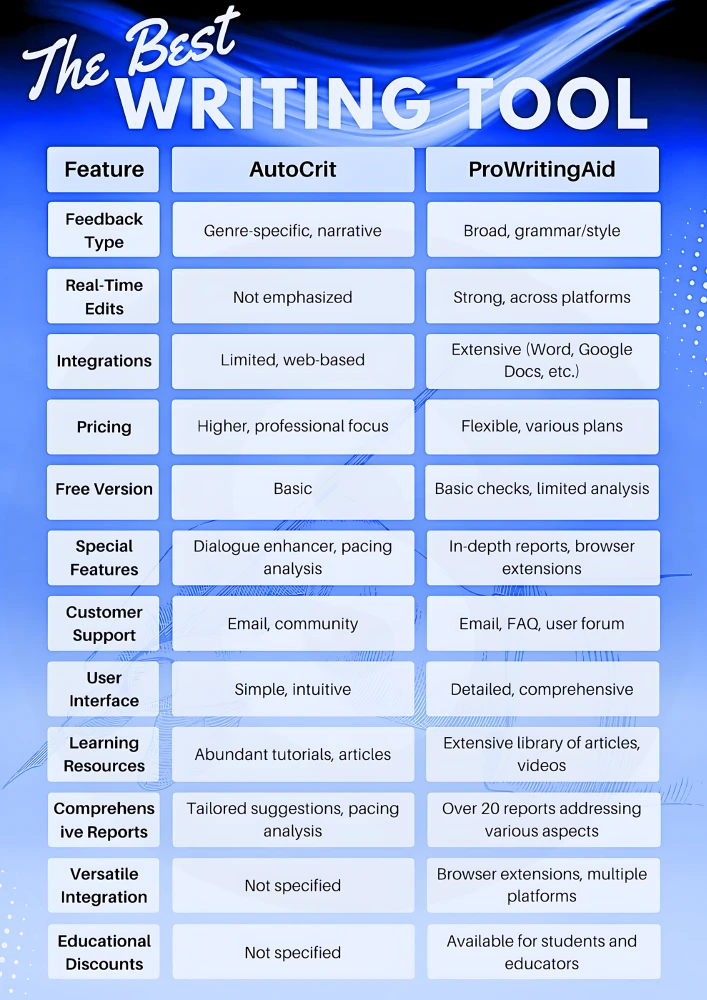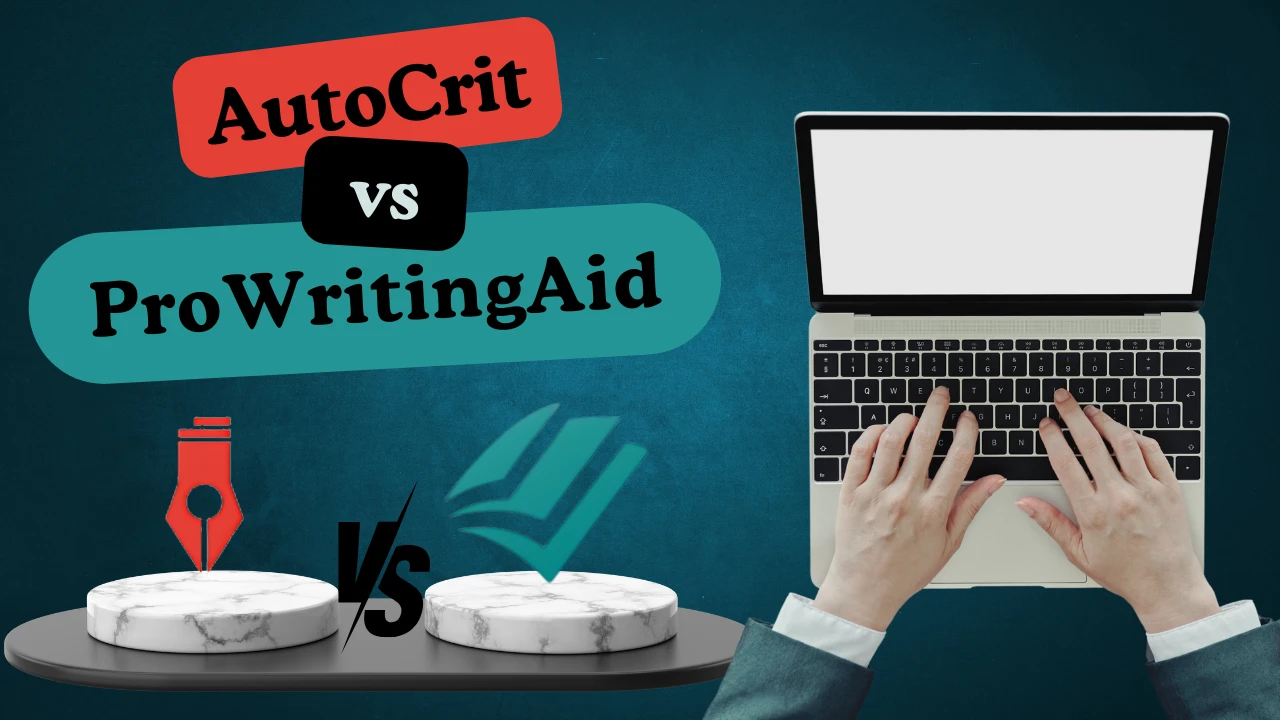AutoCrit vs ProWritingAid
Are you torn between AutoCrit Vs. ProWritingAid? Both tools promise to polish your writing to perfection. Whether you’re crafting your next novel or a captivating blog post, choosing the right editing tool is crucial. Let’s dive into a detailed comparison to help you decide the best fit for your writing needs.
Ease of Use
Finding a tool that’s easy to navigate can significantly enhance your writing process. Let’s compare AutoCrit and ProWritingAid on their usability:
AutoCrit:

- User-Friendly Interface: Designed with simplicity, making it welcoming for all writers.
- Step-by-Step Guidance: Offers clear directions, making the editing process less daunting.
- Focus on Fiction: Tailored features for novelists and manuscript editing.
ProWritingAid:

- Comprehensive Features: Offers a detailed array of reports and tools, with a steeper learning curve.
- Integration: Seamlessly works with Microsoft Word, Google Docs, and other editors.
- Learning Resources: Abundant tutorials and articles to help users maximize its features.
Verdict:
- For ease and simplicity, AutoCrit shines as the more approachable option.
- ProWritingAid rewards those who invest time learning its intricate features with a powerful editing assistant.
Key Features
A deep dive into the features helps to understand how these tools stand apart, and which is better suited for your specific writing needs.
AutoCrit:
- Genre-Specific Feedback: Tailored suggestions based on your genre for more relevant advice.
- Pacing and Momentum Analysis: Helps identify and fix pacing issues in your narrative.
- Dialogue Enhancer: Analyzes your dialogue, providing insights to make conversations more engaging.
ProWritingAid:
- In-depth Reports: Over 20 reports addressing different aspects of your writing like grammar, style, readability, and more.
- Style Suggestions: Offers suggestions to improve the clarity and fluency of your writing.
- Real-Time Grammar Checking: Identifies errors as you write, not just in editing, making the process efficient.
Verdict:
- AutoCrit excels with features tailored for fiction writers, offering genre-specific insights and narrative analysis.
- ProWritingAid stands out as an all-rounder, benefiting a wider audience with its comprehensive reports and real-time assistance.
Both tools offer unique advantages based on your writing style and needs. If focusing on narratives and storytelling, AutoCrit might be your ally. For broader editing support covering various writing aspects, ProWritingAid could be the champion.
Accuracy and Performance
The effectiveness of a writing tool greatly depends on its ability to provide accurate and useful suggestions. Let’s assess AutoCrit and ProWritingAid on these fronts.
AutoCrit:
- Consistency: Highly praised for consistent advice, especially on narrative elements like pacing and dialogue.
- Feedback Relevance: Offers genre-specific feedback, increasing the relevance of its suggestions for fiction writers.
ProWritingAid:
- Grammar and Spelling: Exceptionally accurate in identifying grammatical and spelling errors in real-time.
- Comprehensive Analysis: The depth of reports means not just surface-level errors are caught, but stylistic and complex issues are also addressed.
Verdict:
- For narrative consistency and genre-specific advice, AutoCrit demonstrates strong performance, particularly for fiction writers.
- For grammatical accuracy and a thorough analysis covering a range of writing issues, ProWritingAid offers a robust solution.
Both tools provide valuable insights into your writing, with AutoCrit focusing more on the storytelling aspects, while ProWritingAid delivers an all-encompassing grammar and style check.
Integrations
The value of a writing tool is often enhanced by its ability to integrate with other software and platforms you’re already using. Let’s compare how AutoCrit and ProWritingAid stack up in this domain.
AutoCrit:
- Focus on Web-based Services: Primarily offers a strong, standalone web interface without extensive external integrations.
- Specific Integrations: While limited, includes targeted integrations designed to benefit its core user base of fiction writers.
ProWritingAid:
- Wide Range of Integrations: Compatible with popular writing platforms and tools including Microsoft Word, Google Docs, Scrivener, and more.
- Browser Extensions: Offers extensions for Chrome, Firefox, and Safari, making it versatile across web platforms and social media.
Verdict:
- AutoCrit may lack wide-ranging integrations but focuses on delivering a robust, specialized service for its web-based users.
- ProWritingAid shines with its flexibility, providing a seamless experience across various writing environments and tools.
Integration capabilities greatly enhance usability. If your writing process involves various platforms and tools, ProWritingAid may offer the convenience you need. For web-focused writers, AutoCrit’s streamlined service remains a powerful option.
Pricing and Plans
The decision between AutoCrit and ProWritingAid might ultimately come down to pricing and what each plan offers. Let’s break down the costs and features associated with each tool to see which provides better value for your investment.
AutoCrit:
- Free Version: Limited access to reports and features, suitable for casual writing.
- Professional Membership: Costs around $30/month (with variations for annual plans), providing full access to all features, including genre-specific feedback and pacing analysis.
- Specialized Plans: Occasionally, AutoCrit offers genre-specific packages at different price points.
ProWritingAid:
- Free Version: Offers basic grammar checks and summary reports, with limitations on word count and depth of analysis.
- Premium: Starting at $20/month, with significant discounts for yearly ($79/year) and lifetime ($399 one-time) plans. Unlocks all features, including in-depth reports, unlimited word count, and full integration access.
- Educational Discounts: Available for students and educators at lower rates.
Verdict:
- AutoCrit’s professional membership offers detailed feedback tailored to fiction writers but at a higher monthly cost.
- ProWritingAid presents a more flexible and economical choice with its comprehensive features accessible at lower price points, especially with long-term commitments.
Your budget and specific needs will dictate the best option. For writers seeking detailed narrative feedback and who are okay with a higher investment, AutoCrit’s professional plan may be ideal. If you’re looking for an all-around editing tool with a friendlier price tag, ProWritingAid’s premium plans are worth considering.
Where Each App Shines
While both AutoCrit and ProWritingAid offer valuable features for writers, each has its own areas where it truly excels. Identifying these can help you choose the tool that best aligns with your writing goals.
AutoCrit:
Excellence in Fiction and Narrative Feedback
- Tailored Feedback for Fiction: With its focus on genre-specific advice, AutoCrit is unparalleled for novelists and fiction writers seeking to enhance their narrative.
- Pacing and Momentum Analysis: It stands out in its ability to analyze and provide feedback on the pacing of your story, ensuring readers remain engaged from start to finish.
- Dialogue Enhancements: AutoCrit can dissect your dialogue, offering insights to make character conversations more authentic and compelling.
ProWritingAid:
Comprehensive Grammar and Style Improvement
- Broad Range of Reports: ProWritingAid offers over 20 different reports on grammar, style, readability, and more, making it a comprehensive tool for polishing every aspect of your writing.
- Real-Time Error Correction: Its ability to catch errors in real-time as you write is a significant advantage for writers who prefer immediate feedback.
- Versatile Integration: With its wide array of integrations, ProWritingAid easily fits into your existing writing ecosystem, whether you’re drafting a blog post in Google Docs or crafting a novel in Scrivener.
Verdict:
- AutoCrit shines brightest for authors deep in the process of crafting narratives, where the nuance of storytelling is paramount.
- ProWritingAid is the go-to for writers who value thoroughness in grammar, style, and readability checks across various platforms and writing spaces.
Each tool has carved out its niche excellently. Your choice should hinge on what aspect of your writing you’re looking to improve: the storytelling prowess of AutoCrit or the grammatical fortress that ProWritingAid promises to build.
Customer Support and Resources
Beyond the features and pricing, the support and resources provided by a writing tool can enhance your experience and help you get the most out of the software. Let’s evaluate AutoCrit and ProWritingAid in terms of their customer service and educational material.
AutoCrit:
- Support Channels: Email support with a turnaround time of around 24-48 hours. Some users report wishing for quicker responses.
- Resources: Offers an array of writing guides, webinars, and a blog packed with writing tips, especially useful for fiction writers.
- Community: Boasts a member community that provides mutual support and sharing of writing insights.
ProWritingAid:
- Support Channels: Includes email support, but also offers a more robust FAQ section and a user forum for peer assistance.
- Resources: Features an extensive library of articles, videos, webinars, and an annual writing conference that covers a wide range of writing and editing topics.
- Community Engagement: Actively engages with its user base through social media channels, webinars, and by participating in writer conferences.
Verdict:
- AutoCrit wins with its specialized resources for fiction writers, though its support system may feel limited to some users.
- ProWritingAid stands out with its comprehensive suite of resources and multiple avenues for support, catering to a wide audience of writers.
Access to quality support and rich educational content can significantly impact your writing journey. Whether you’re looking for specialized fiction writing guidance or broader writing support, both AutoCrit and ProWritingAid offer valuable resources, though ProWritingAid provides a bit more in terms of community engagement and learning materials.
Pros and Cons of Each Tool
When choosing between AutoCrit and ProWritingAid, weighing the advantages and disadvantages is crucial. Here’s a snapshot of the pros and cons associated with each tool to help guide your decision.
AutoCrit Pros:
- Tailored Feedback for Fiction: Focuses on narrative, pacing, and dialogue, ideal for novelists.
- Genre-Specific Advice: Offers suggestions based on your specific writing genre.
- Easy to Navigate: User-friendly interface with straightforward guidance.
AutoCrit Cons:
- Limited Integrations: Majorly a standalone web service with minimal external software integrations.
- Higher Price Point: Monthly membership can be slightly on the higher side compared to some alternatives.
- Focused Mainly on Fiction: This may not cater as effectively to non-fiction writers or academic writing.
ProWritingAid Pros:
- Comprehensive Writing Reports: Over 20 different reports covering grammar, style, readability, and more.
- Extensive Integrations: Works seamlessly with MS Word, Google Docs, and Scrivener, and has browser extensions.
- Flexible Pricing: Offers a range of pricing options including a limited free version, annual, and lifetime plans.
ProWritingAid Cons:
- Steep Learning Curve: With its extensive features, it might take time to fully utilize the tool.
- Occasional Glitches: Some users report occasional issues with real-time editing and integration functionalities.
- Overwhelming for Beginners: The sheer number of reports and suggestions might be daunting for novice writers.

Conclusion
Choosing between AutoCrit and ProWritingAid ultimately depends on your writing goals, preferences, and budget. If you’re a fiction writer seeking tailored feedback and guidance on narrative elements, AutoCrit might be your best bet. On the other hand, if you’re looking for a comprehensive writing assistant with a wide range of features and integrations, ProWritingAid offers excellent value for your investment. Take advantage of free trials, explore their features, and consider how each tool aligns with your writing process before making your decision. Happy writing!


This is a good article
ProWritingAid is known for its extensive array of online resources, including a blog and a web-based user guide. AutoCrit also offers support but tends to focus more on direct customer service inquiries through email.
Thanks for the insights! I’m gearing up to delve deeper into both ProWritingAid and AutoCrit soon, with plans to explore each app extensively to uncover their full potential. I’m eager to cover all the points you mentioned, + how-to guides and exploring every facet of maximizing their utility. Your input will definitely guide my exploration. Cheers!
wonderful
Usually I do not read article on blogs however I would like to say that this writeup very compelled me to take a look at and do it Your writing style has been amazed me Thank you very nice article.